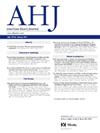Implications of an off-hours setting in patients undergoing transcatheter edge-to-edge repair for mitral regurgitation
IF 3.7
2区 医学
Q1 CARDIAC & CARDIOVASCULAR SYSTEMS
引用次数: 0
Abstract
Background
Little is known about transcatheter edge-to-edge repair (TEER) for mitral regurgitation (MR) that is performed outside of usual working hours. We aimed to explore the prevalence, correlates, and outcomes of mitral TEER initiated off-hours, ie, before 7:30 am, after 5:30 pm, or on weekends/holidays.
Methods
A single-center registry of isolated, first-time interventions was retrospectively analyzed in its entirety and after propensity-score matching. Outcomes included all-cause mortality, heart failure (HF) hospitalizations, and the persistence of MR and functional incapacitation along the first postprocedural year.
Results
A total of 1,177 procedures were studied. Of them, 117 (9.9%) took place off-hours. These were more often urgent interventions (30.8% vs. 14.3%, P < .001) performed in the midst of acute HF / hemodynamic compromise and on individuals with greater comorbidity, more advanced HF, and higher interventional risk. Overall procedural features were unaffected by interventional timing, and a high (>97%) technical success rate was achieved unanimously. MR severity and functional class similarly improved from baseline in the 2 study groups. Deaths and the composite of deaths or HF hospitalizations occurred earlier and more frequently following off-hours procedures (18.8% vs. 11.5%, P = .022 and 33.3% vs. 24.6%, P = .040, respectively). None of the explored endpoints’ risks were independently associated with procedural timing. Within a 234-patient, 1-to-1 matched sub-cohort, no inter-group differences were observed in pre-, intra-, and postprocedural findings and outcomes.
Conclusions
A noninfrequent procedure, off-hours mitral TEER is performed in high-risk cases but, in the hands of experienced interventionalists, should prove safe, feasible, and efficacious.

二尖瓣反流患者行经导管边缘对边缘修复的非工作时间设置的意义。
背景:在正常工作时间以外进行二尖瓣经导管边缘到边缘修复(TEER)的研究很少。我们的目的是探讨二尖瓣TEER在非工作时间(即早上7:30之前、下午5:30之后或周末/假期)的患病率、相关性和结果。方法:-对孤立的、首次干预的单中心登记进行回顾性分析,并在倾向评分匹配后进行整体分析。结果包括全因死亡率、心力衰竭住院、术后第一年持续出现明显的二尖瓣反流(MR)和功能丧失。结果:共研究了1177例手术。其中117起(9.9%)发生在非工作时间。这些是更常见的紧急干预(30.8%对14.3%,p97%)技术成功率达到一致。在两个研究组中,MR的严重程度和功能等级与基线相比有相似的改善。非工作时间手术后,死亡和合并死亡或HF住院的情况发生得更早、更频繁(分别为18.8%对11.5%,p=0.022和33.3%对24.6%,p=0.040)。所有研究终点的风险均与手术时机无关。在234例患者中,1对1匹配的亚队列中,在手术前、手术中和手术后的发现和结果中没有观察到组间差异。结论:在高危病例中,非工作时间二尖瓣TEER是一种不常见的手术,但在经验丰富的介入医师手中,应被证明是安全、可行和有效的。
本文章由计算机程序翻译,如有差异,请以英文原文为准。
求助全文
约1分钟内获得全文
求助全文
来源期刊

American heart journal
医学-心血管系统
CiteScore
8.20
自引率
2.10%
发文量
214
审稿时长
38 days
期刊介绍:
The American Heart Journal will consider for publication suitable articles on topics pertaining to the broad discipline of cardiovascular disease. Our goal is to provide the reader primary investigation, scholarly review, and opinion concerning the practice of cardiovascular medicine. We especially encourage submission of 3 types of reports that are not frequently seen in cardiovascular journals: negative clinical studies, reports on study designs, and studies involving the organization of medical care. The Journal does not accept individual case reports or original articles involving bench laboratory or animal research.
 求助内容:
求助内容: 应助结果提醒方式:
应助结果提醒方式:


